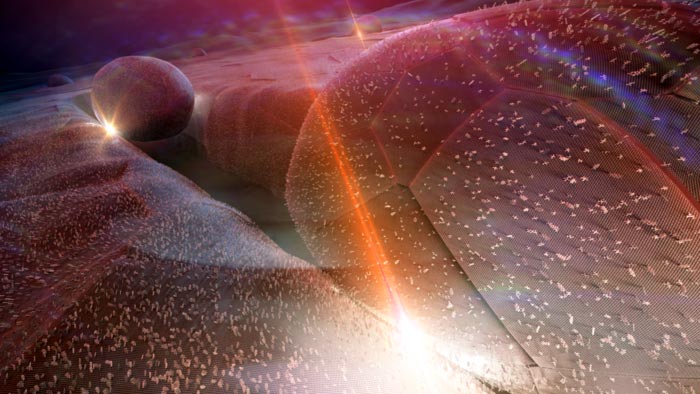Molecular device turns infrared into visible light

Artistic view of the nanoparticle-in-groove plasmonic cavities. Molecules cover the gold film and are sandwiched between the groove and the 150-nm large nanoparticle. The infrared signal of interest comes from below the substrate while the pump laser providing energy for upconversion comes from the top. Both are focused by the cavity onto the molecules, and interact with their internal vibrations to generate an upconverted copy of the infrared signal at visible frequencies (bright spot).
Credit: Nicolas Antille (http://www.nicolasantille.com) (Media purposes only)
Light is an electromagnetic wave: it consists of oscillating electric and magnetic fields propagating through space. Every wave is characterized by its frequency, which refers to the number of oscillations per second, measured in Hertz (Hz). Our eyes can detect frequencies between 400 and 750 trillion Hz (or terahertz, THz), which define the visible spectrum. Light sensors in cell phone cameras can detect frequencies down to 300 THz, while detectors used for internet connections through optical fibers are sensitive to around 200 THz.
At lower frequencies, the energy transported by light isn’t enough to trigger photoreceptors in our eyes and in many other sensors, which is a problem given that there is rich information available at frequencies below 100 THz, the mid- and far-infrared spectrum. For example, a body with surface temperature of 20°C emits infrared light up to 10 THz, which can be “seen” with thermal imaging. Also, chemical and biological substances feature distinct absorption bands in the mid-infrared, meaning that we can identify them remotely and non-destructively by infrared spectroscopy, which has myriads of applications.
Turning infrared into visible light
Scientists at EPFL, Wuhan Institute of Technology, the Valencia Polytechnic University, and AMOLF in the Netherlands, have now developed a new way to detect infrared light by changing its frequency to that of visible light. The device can extend the “sight” of commonly available and highly sensitive detectors for visible light far into the infrared. The breakthrough is published in Science.
Frequency conversion is not an easy task. The frequency of light is a fundamental that cannot easily change by reflecting light on a surface or passing it through a material because of the law of energy conservation.
The researchers worked around this by adding energy to infrared light with a mediator: tiny vibrating molecules. The infrared light is directed to the molecules where it is converted into vibrational energy. Simultaneously, a laser beam of higher frequency impinges on the same molecules to provide the extra energy and convert the vibration into visible light. To boost the conversion process, the molecules are sandwiched between metallic nanostructures that act as optical antennas by concentrating the infrared light and laser energy at the molecules.
A new light
“The new device has a number of appealing features,” says Professor Christophe Galland at EPFL’s School of Basic Sciences, who led the study. “First, the conversion process is coherent, meaning that all information present in the original infrared light is faithfully mapped onto the newly created visible light. It allows high-resolution infrared spectroscopy to be performed with standard detectors like those found in cell-phone cameras. Second, each device is about a few micrometers in length and width, which means it can be incorporated into large pixel arrays. Finally, the method is highly versatile and can be adapted to different frequencies by simply choosing molecules with different vibrational modes.”
“So far, however, the device’s light-conversion efficiency is still very low,” cautions Dr Wen Chen, first author of the work. “We are now focusing our efforts in further improving it” – a key step toward commercial applications.
Other contributors
Friedrich Schiller University Jena
Reference
Wen Chen, Philippe Roelli, Huatian Hu, Sachin Verlekar, Sakthi Priya Amirtharaj, Angela I. Barreda, Tobias J. Kippenberg, Miroslavna Kovylina, Ewold Verhagen, Alejandro Martínez, Christophe Galland. Continuous-Wave Frequency Upconversion with a Molecular Optomechanical Nanocavity. Science 03 December 2021. DOI: 10.1126/science.abk3106
Journal: Science
DOI: 10.1126/science.abk3106
Article Title: Continuous-Wave Frequency Upconversion with a Molecular Optomechanical Nanocavity.
Article Publication Date: 3-Dec-2021
Media Contact
Nik Papageorgiou
Ecole Polytechnique Fédérale de Lausanne
n.papageorgiou@epfl.ch
Office: 41-216-932-105
All latest news from the category: Physics and Astronomy
This area deals with the fundamental laws and building blocks of nature and how they interact, the properties and the behavior of matter, and research into space and time and their structures.
innovations-report provides in-depth reports and articles on subjects such as astrophysics, laser technologies, nuclear, quantum, particle and solid-state physics, nanotechnologies, planetary research and findings (Mars, Venus) and developments related to the Hubble Telescope.
Newest articles

Innovative 3D printed scaffolds offer new hope for bone healing
Researchers at the Institute for Bioengineering of Catalonia have developed novel 3D printed PLA-CaP scaffolds that promote blood vessel formation, ensuring better healing and regeneration of bone tissue. Bone is…

The surprising role of gut infection in Alzheimer’s disease
ASU- and Banner Alzheimer’s Institute-led study implicates link between a common virus and the disease, which travels from the gut to the brain and may be a target for antiviral…

Molecular gardening: New enzymes discovered for protein modification pruning
How deubiquitinases USP53 and USP54 cleave long polyubiquitin chains and how the former is linked to liver disease in children. Deubiquitinases (DUBs) are enzymes used by cells to trim protein…


